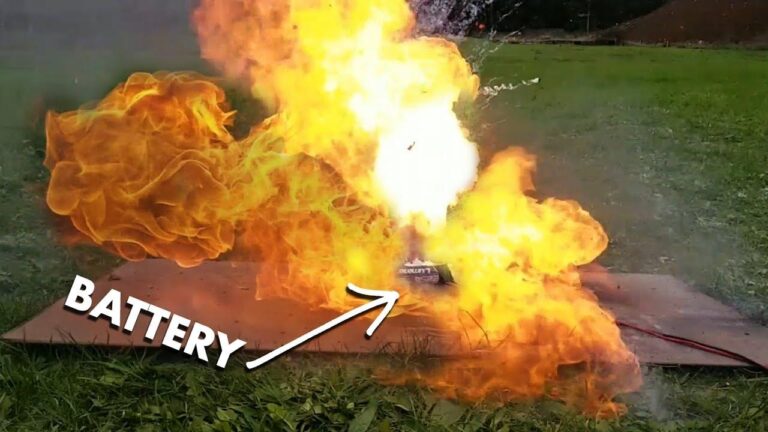A lithium-ion battery exploded in a La Jolla apartment, causing extensive damage and raising safety concerns. The incident, reported earlier today, prompted a swift response from local emergency services. Residents and authorities are investigating the cause of the explosion, which highlights the ongoing risks associated with lithium-ion battery use in residential settings. More details on the event and its aftermath are emerging as San Diego News Daily continues to follow the story.
Lithium-ion Battery Explosion Sparks Safety Concerns in La Jolla Apartment
Residents of a La Jolla apartment complex were startled when a lithium-ion battery suddenly exploded late Thursday evening, igniting a small fire that quickly brought emergency responders to the scene. The explosion originated from a portable electronic device charging in a living area, raising alarms about the safe use and storage of high-capacity batteries in residential settings. Fortunately, no severe injuries were reported, but the incident has prompted a thorough investigation by fire safety officials to determine the cause and prevent future occurrences.
Key safety reminders emphasized by local authorities following the explosion include:
- Never leave batteries charging unattended, especially overnight.
- Use manufacturer-approved chargers to avoid overheating risks.
- Avoid placing charging devices near flammable materials.
- Regularly inspect batteries for swelling, damage, or defects.
| Battery Type | Common Risk | Recommended Action |
|---|---|---|
| Lithium-ion | Overheating & Fire | Use certified chargers, avoid overcharging |
| Nickel-Cadmium | Memory Effect | Periodic full discharge cycles |
| Lead-Acid | Acid Leaks | Store upright, handle with care |
Experts Reveal Causes Behind Lithium-ion Battery Failures
Industry specialists point to several key factors triggering failures in lithium-ion batteries, with thermal runaway leading the list. Excessive heat generation inside the battery cell can cause rapid temperature escalation, resulting in swelling, smoke, and, in extreme cases, explosions. Manufacturing defects such as internal short circuits and poor cell quality also drastically increase the risk of catastrophic failure. Additionally, improper charging—using incompatible chargers or overcharging beyond recommended voltage—has been cited as a frequent cause in many investigation reports.
Environmental and usage conditions further exacerbate vulnerabilities. Experts highlight these primary contributors:
- Physical damage: Dropping or puncturing can compromise internal separators.
- Exposure to high temperatures: Prolonged heat exposure speeds chemical degradation.
- Deep discharge cycles: Repeated extreme draining can shorten battery lifespan.
| Cause | Effect | Preventive Measure |
|---|---|---|
| Thermal Runaway | Fire/Explosion | Use certified chargers, monitor temperature |
| Physical Damage | Internal Short Circuit | Handle batteries carefully |
| Overcharging | Capacity Loss, Swelling | Follow manufacturer guidelines |
Emergency Response Teams Explain Safety Protocols for Battery-Related Fires
Firefighters and emergency responders emphasize the unique dangers posed by lithium-ion battery fires, highlighting that traditional extinguishing methods might not suffice. These batteries, commonly found in smartphones, laptops, and electric vehicles, can ignite violently if damaged or improperly charged. The rapid release of flammable electrolyte and intense heat generation creates a risk of explosion, requiring specialized training and equipment to manage safely.
Officials urge residents to follow critical safety protocols to minimize risks associated with battery-related fires. Key recommendations include:
- Immediately evacuate the area if a battery starts to smoke or emit a burning smell.
- Use a Class D fire extinguisher specifically designed for metal fires, if available.
- Do not use water to extinguish lithium-ion battery fires, as it may worsen the blaze.
- Secure damaged batteries in a non-flammable container filled with sand or salt to isolate heat and prevent reignition.
| Safety Step | Why It Matters |
|---|---|
| Evacuate Immediately | Prevents injury from toxic smoke and explosions |
| Use Proper Extinguisher | Targets battery fire without exacerbating chemical reactions |
| Avoid Water | Water can react with lithium and intensify fire |
| Isolate Battery | Prevents spread and controls heat buildup |
Preventive Measures Residents Can Take to Avoid Lithium-ion Battery Hazards
To significantly reduce the risk of lithium-ion battery incidents, residents should ensure proper handling and storage techniques. Always use chargers and power adapters specified by the device manufacturer, avoiding cheap or counterfeit alternatives that can cause overheating. Store batteries in a cool, dry place away from direct sunlight and flammable materials. Additionally, it is crucial to regularly inspect batteries for swelling, leaks, or unusual odors, as these are warning signs of potential failure.
- Charge devices on non-flammable surfaces and avoid overnight charging to prevent overheating.
- Keep batteries away from water and avoid exposing them to extreme temperatures.
- Dispose of damaged or old batteries at designated e-waste centers rather than in household trash.
- Avoid puncturing or crushing batteries, which can cause internal short circuits.
| Common Battery Risk | Preventive Action |
|---|---|
| Overcharging | Unplug when fully charged |
| Using incompatible chargers | Use OEM chargers only |
| Physical damage | Handle carefully, avoid drops |
| Exposure to heat | Store in cool, ventilated areas |
Key Takeaways
The unexpected lithium-ion battery explosion in the La Jolla apartment serves as a stark reminder of the potential dangers associated with everyday electronics. Authorities continue to investigate the incident to determine the exact cause and prevent future occurrences. Residents are urged to exercise caution when charging and handling battery-powered devices to ensure their safety. NBC 7 San Diego will provide updates as more information becomes available.







